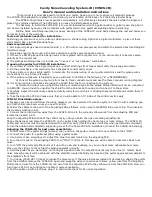
Page 12
6-11
Series 3050 Btu Monitor
Solid State Switch and Form “C” Output Wiring
The Series 3050 Btu Monitor has one Normally Open (N.O.) solid state switch, and one solid state form “C” relay.
Check the Specifications on page 29 for maximum voltage and current ratings for each type output. These outputs are
completely independent, electrically isolated, and can be programmed as either Pulse or Set Point outputs.
When the “Totalizer” function is selected, the unit of measure and resolution are independent from the displayed units and
can be programmed where one pulse occurs once every 0000000.1 to 999999999. of units selected, with any pulse width
from 0001 to 9999mS.
When the “Alarm” is selected as the unit of measure and the resolution is independent from the displayed units, it allows the
unit to be programmed as either a high or low rate Set Point. Since the Set Point, Release Point and their associated time
delays are fully independent, this output can be either a classical high rate or low rate alarm, depending on the settings
selected. When design planning, keep in mind that although both of these outputs can be programmed as alarm points only,
the relay provides both N.O. and N.C. contacts. The switch is a simple N.O. contact.
Examples:
High Flow Set Point Control
The Set Point must be a value greater than the Release Point.
The relay output will have continuity between its N.C. terminal and “COM” until the flow has exceeded the Set Point (“SETPT”)
for a continuous period of time exceeding the Set Point Delay (“SDLY”), at which time the N.C. connection will open and the
N.O. contact will have continuity to the “COM” terminal. When the flow has dropped below the Release Point (“RELP") for a
continuous period of time exceeding the Release Point Delay (“RDLY”), the relay states will return to their original states. If the
latch has been set to “ON”, the relay will not release until manually reset once the Set Point and Set Delay have been satisfied.
Sources for the Set Point control can be Flow Rate, Energy Rate, T1, T2 or Delta T.
Low Flow Set Point Control
The Set Point must be a value less than the Release Point.
The relay output will have continuity between its N.C. terminal and “COM” until the flow drops below the Set Point (“SETPT”)
for a continuous period of time exceeding the Set Point Delay(“SDLY”), at which time the N.C. connection will open and the
N.O. contact will have continuity to the “COM” terminal. When the flow has again risen above the Release Point (“RELP”) for a
continuous period of time exceeding the Release Point Delay (“RDLY”), the relay states will return to their original states. If the
latch has been set to “ON”, the relay will not release until manually reset once the Set Point and Set Delay have been satisfied.
Sources for the Set Point control can be Flow Rate, Energy Rate, T1, T2 or Delta T.
1 RELAY 1 NO
2 RELAY 1 NC
3 RELAY 1 COM
4 PULSE 1 OUT
5 PULSE 2 OUT
Figure 9: Relay and Switch Wiring Examples
Summary of Contents for Impeller Data Industrial 3050 Series
Page 2: ...Series 3050 Btu Monitor Page ii 6 11...
Page 4: ...Series 3050 Btu Monitor Page iv 6 11...
Page 18: ...Page 18 6 11 Series 3050 Btu Monitor Page 13 Programming Flow Chart...
Page 19: ...Page 19 6 11 Installation Operation Manual...
Page 20: ...Page 20 6 11 Series 3050 Btu Monitor Page 15...
Page 21: ...Page 21 6 11 Installation Operation Manual Page 16...
Page 22: ...Page 22 6 11 Series 3050 Btu Monitor Page 17...
Page 23: ...Page 23 6 11 Installation Operation Manual Page 18...
Page 30: ...Page 30 6 11 Series 3050 Btu Monitor Intentionally blank page...
Page 31: ...Page 31 6 11 Installation Operation Manual Intentionally blank page...













































